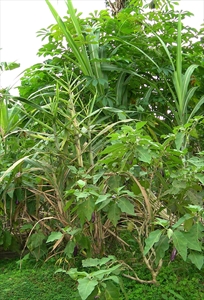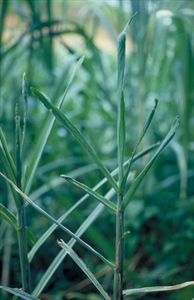Fiji disease of sugarcane; also known as Fiji leaf gall.
Pacific Pests, Pathogens, Weeds & Pesticides - Online edition
Pacific Pests, Pathogens, Weeds & Pesticides
Sugarcane Fiji disease (077)
Sugarcane Fiji disease fijivirus; the abbreviation is FDV. The particles are 70 um in diameter, and belong to the family Reoviridae.
Asia, Africa, Oceania. It is recorded from Australia, Fiji, New Caledonia, Papua New Guinea, Samoa, Solomon Islands, Tonga, and Vanuatu.
Sugarcane (Saccharum officinarum); lowland pitpit (Saccharum edule), and other Saccharum species.
Unusually for a virus, the symptoms include gall formation, and the appearance of galls is an early symptom. They occur on the underside of the leaf, on the midrib or larger veins (Photo 1). The galls vary in size from those that can only just be seen with the eye to those that are 50 mm long, 2-3 mm wide and 1-2 mm high. The galls are characteristic of the disease, and important in distinguishing sugarcane Fiji disease from other sugarcane diseases.
Infected leaves are dark green, very stiff and short (Photo 2). They may have very irregular margins (it is called 'bitten-off') and the top of the plant may have the appearance of a fan, as if chewed by animals (Photo 3). The growing point may die and on some varieties axillary bud development gives a witches' broom effect (Photo 4). Plants do not recover from the disease: they become severely stunted and grass-like on ratooning, and eventually die.
Sugarcane Fiji disease virus is spread in Solomon Islands and presumably in other Pacific island countries by a species of Perkinsiella (most likely Perkinsiella saccharicida), a planthopper (Photo 5), which breeds among the young leaves. The adult planthoppers have wings, allowing them to fly from diseased to healthy plants. All stages of Perkinsiella are capable of spreading the virus. The insects take in the virus as they feed, the virus multiplies inside the insects and, after 2-4 weeks incubation, the insects can pass the virus to healthy sugarcane.
The disease is also spread in planting material. Farmers do not always realise that plants chosen for propagation are diseased. Early symptoms are mild and easily missed.
In the past, the virus has caused severe damage to commercial sugarcane in Fiji and Australia. Planting large areas of susceptible varieties caused epidemics in these two countries. For instance, in 1979, there were 70 million plants present with this virus disease in the Bundaberg district of Queensland. This was when the variety NCo310 was grown. In general, in Pacific island countries, the situation is different. With the exception of Fiji and Papua New Guinea, sugarcane is rarely planted in plantations: it occurs as a few plants in a garden, and over many generations the varieties grown may have been selected for resistance. Whatever the reason, the number of plants affected is relatively low. In these situations, it is not a serious disease. For a summary of the history of the disease in Australia and its control see: https://sugarresearch.com.au/wp-content/uploads/2017/03/Fiji-leaf-gall-IS13003-2.pdf.
Look for galls (outgrowths) on the under surface of the leaves, along the midrib and large veins. Look for leaves, which are short, stiff, and horizontal. The diseased plants look as if cattle have eaten them. Look for stems where the buds have developed, giving bunches of leaves along the stem, called a witches' broom effect. The virus particles are 70 um in diameter.
The virus can be detected in ELISA tests, and also by molecular tests using PCR.
BIOSECURITY
Because diseases of sugarcane are unevenly distributed throughout the world, all efforts should be made to prevent their further spread. The movement of untreated consignments of sugarcane internationally for commercial purposes (food or planting) should be avoided, and exchanges of germplasm belonging to Saccharum species for crop improvement programs should follow the FAO/IBPGR Technical Guidelines for the Safe Movement of Sugarcane Germplasm. Frison EA, Putter CAJ (eds.). 1993. Rome, Italy: (https://www.bioversityinternational.org/fileadmin/_migrated/uploads/tx_news/Sugarcane_259.pdf). The Guidelines stipulate the therapy and indexation that should be used.
CULTURAL CONTROL
Before planting:
- Do not use any of the stems from a diseased plant for propagation, even if some stems appear healthy; they will develop the disease later.
During growth:
- Remove plants as soon as symptoms are seen, and burn them.
- When pulling out the plants look to see if insects are present in the young leaves; if they are, hold the leaves together to stop them from escaping and spreading the virus. Burn the plants, and insects.
After harvest:
- Collect and burn the diseased plants and debris.
RESISTANT VARIETIES
Commercial varieties with resistance to Fiji disease have been bred in Australia, Papua New Guinea and Fiji, but whether they have the characteristics demanded by home gardeners is not known. If new varieties were to be introduced to countries were Sugarcane Fiji disease virus is not yet established, it is important that they are indexed according to the FAO/IBPGR Technical Guidelines for the Safe Movement of Sugarcane Germplasm (http://www.bioversityinternational.org/e-library/publications/detail/sugarcane/).
CHEMICAL CONTROL
The use of insecticides on sugarcane grown for commercial use is not recommended as varietal resistance adequately controls the disease. It is not recommended for sugarcane grown for household use either, because of costs and the hazards involved in their application.
AUTHORS Helen Tsatsia & Grahame Jackson
Information from SRA (2015) Information sheet ISI5001. Sugarcane Research Australia. (https://sugarresearch.com.au/wp-content/uploads/2017/03/Fiji-leaf-gall-IS13003-2.pdf); and Fiji leaf gall (2018) SRA Sugarcane Research Australia (https://sugarresearch.com.au/sugar_files/2017/03/Fiji-Gall-Leaf-Info-Sheet_2018-F.pdf); and from CABI (2012) Fiji disease virus (fiji disease of sugar cane). Crop Protection Compendium. (https://www.cabi.org/cpc/datasheet/49800). Photo 1 Bureau of Sugar Experimental Stations, Australia.
Produced with support from the Australian Centre for International Agricultural Research under project PC/2010/090: Strengthening integrated crop management research in the Pacific Islands in support of sustainable intensification of high-value crop production, implemented by the University of Queensland and the Secretariat of the Pacific Community.








